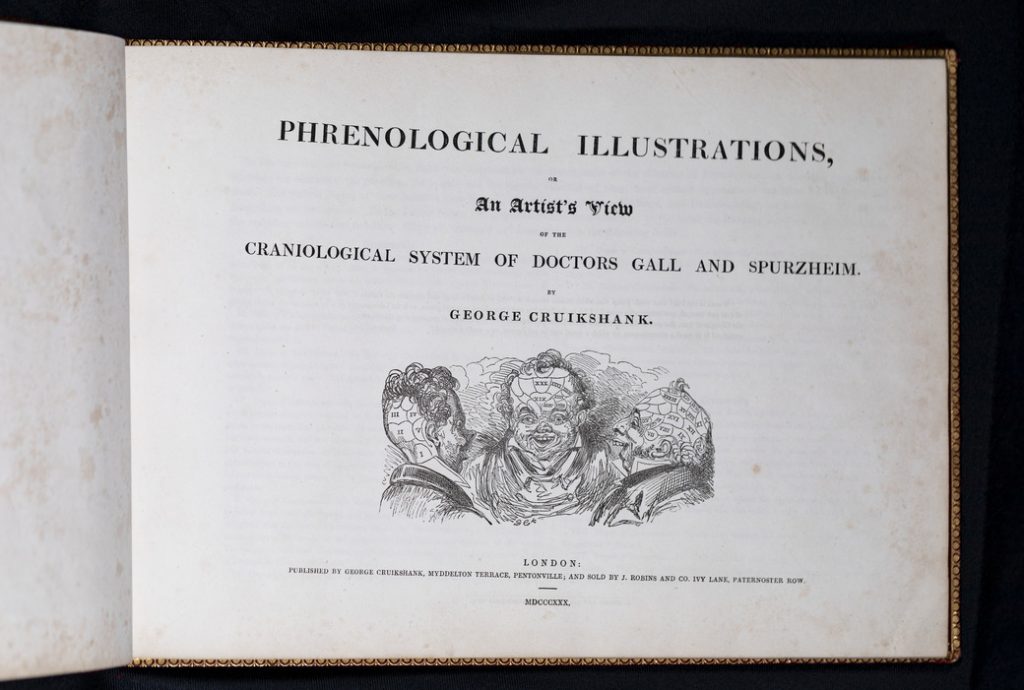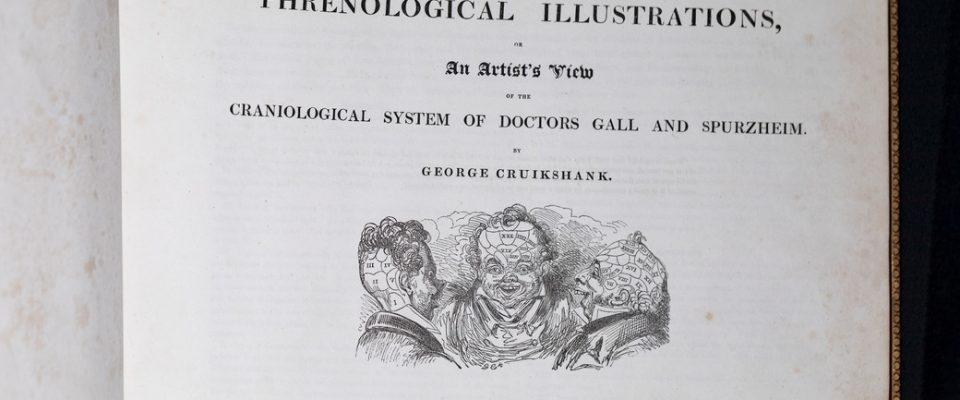By Corinne Newsome

Phrenology, now classified as a pseudoscience, is a psychological theory that began with Dr. Franz Gall, who proposed that the skull conforms to defects in the brain such that bumps on the skull reveal mental illnesses, personality traits, or morality. Think of it as literally “having your head examined.” A doctor or psychologist would feel your head and give you a diagnosis based on which area of the skull they could feel a bump or concavity. Phrenology was largely used to justify racism as well as discrimination against minority groups and the mentally ill.
George Cruikshank’s “Imitation & Approbation” is from a larger collection of images, his 1830 illustration book Phrenological Illustrations, or An Artist’s View of the Craniological System of Doctors Gall and Spurzheim. The sketch depicts a man in a lab coat and goggles, holding a skull with sectional markings, while a rapt audience watches and applauds.

The speaker is wearing what appears to be a white lab coat, as well as goggles, and is referring to the skull in his hand as he addresses the audience. The table upon which he is working is covered with a cloth that appears decorative. What appear to be two decorative objects rest atop the table at each of the front corners, one of which is placed in front of two more skulls, the other in front of a cup of water. The man is also addressing his audience on a brightly lit stage with what appears to be a door leading backstage to the man’s right.
The audience he is speaking to appears to be from a middle class background in front, while a wealthier group of three is sectioned off closer to the direction of the door. Irrespective of their financial background, all members of the audience have expressions of interest, wonder, or amazement, with the audience directly in front of the man openly applauding.
George Cruikshank had been critical of pseudoscience in other illustrations such as “The Fox and the Goose,” discussed in a previous blog post. Phrenology was popularized as a science by Johann Spurzheim, the student and intended successor of Dr. Franz Gall, who popularized it as a medical practice. Spurzheim was known to use images and busts as a way to demonstrate the craniographic approach to phrenology, clearly demonstrated with the man on the stage in the illustration.
Phrenology was debunked as a pseudoscience in a widely popular paper by anatomist Dr. John Gordon in 1815, which criticized Dr. Gall, Spurzheim, and phrenology in general. Spurzheim attempted to refute Gordon and reaffirm the legitimacy of the practice. What decided the fate of phrenology was who an audience believed in more, a Fellow of the Royal Society of Edinburgh or a traveling lecturer. Rather than a game of wits or a battle of the brains, the conflict was more of a contest between the two doctors, each weaponizing their reputation within the field of medicine to convince the public that they knew best.
Though we can’t be sure what George Cruikshank’s personal feelings regarding Spurzheim were, the portrayal of the doctor’s lectures suggest a performance reminiscent of what earned him his popularity among British and French audiences, a flare for performance and rhetoric. However, what is clear is that the entire debate concerning the legitimacy of the practice provided ample entertainment for the masses within Europe who bore witness to it, regardless of whether they believed it or not.
To learn more about George Cruikshank’s life as well as his illustrations, visit George Cruikshank Illustrations and Papers at the UMBC Digital Collections!


 Albin O. Kuhn Library & Gallery
Albin O. Kuhn Library & Gallery